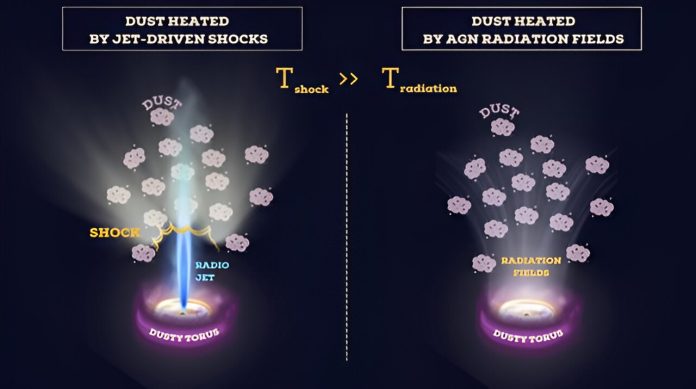
Scientists have used the James Webb Space Telescope (JWST) to uncover a hidden layer of dust in a galaxy 70 million light-years away.
This discovery, led by researchers from Newcastle University, has revealed surprising insights about how this dust is heated.
Instead of being warmed by radiation from the galaxy’s supermassive black hole, the dust is heated by gas collisions moving at near light speed.
These findings were led by Houda Haidar, a Ph.D. student, and published in the Monthly Notices of the Royal Astronomical Society.
Houda and her team are part of the Galactic Activity, Torus, and Outflow Survey (GATOS), an international group studying nearby galaxies with JWST.
They had the exciting opportunity to work with some of the first JWST observations.
“Working with exclusive JWST data and accessing these stunning images before anyone else is beyond thrilling,” said Houda. “Being part of the GATOS team and collaborating with leading experts is truly a privilege.”
Astronomers define an active galactic nucleus (AGN) as a supermassive black hole, millions to billions of times the mass of the sun, that grows by consuming gas. In many AGN, thick clouds of dust and gas block the view from Earth. However, JWST’s infrared vision can see through this dust, revealing the hidden core and detailing the dust structure across hundreds of light-years.
The new JWST images of the galaxy ESO 428-G14 show that much of the dust near the supermassive black hole is spread along the radio jet. The research found a surprising link between the dust and the radio jet, suggesting that the jet itself might be responsible for heating and shaping the dust.
Dr. David Rosario, a senior lecturer at Newcastle University and co-author of the study, noted, “There is a lot of debate about how AGN transfer energy into their surroundings. We did not expect to see radio jets doing this sort of damage. And yet, here it is.”
By studying dust near supermassive black holes, scientists learn how galaxies recycle their material, helping us understand how supermassive black holes influence galaxies, including our own.



